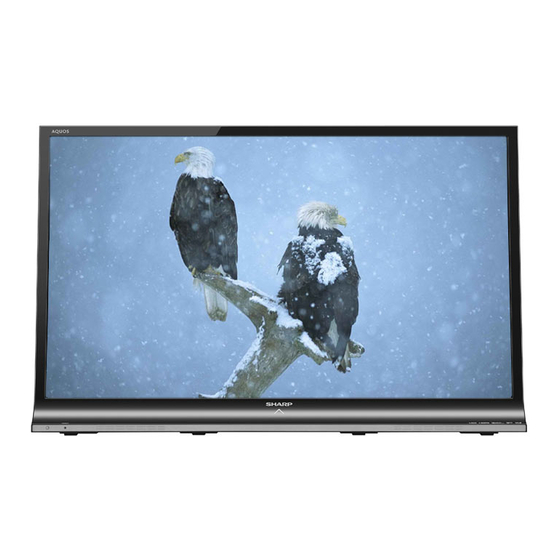Sharp AQUOS CD-BA250 Panduan Pengoperasian - Halaman 29
Jelajahi secara online atau unduh pdf Panduan Pengoperasian untuk Sistem stereo Sharp AQUOS CD-BA250. Sharp AQUOS CD-BA250 36 halaman. Led backlight tv
Juga untuk Sharp AQUOS CD-BA250: Panduan Pengoperasian (32 halaman), Panduan Cepat (4 halaman)

Appendix
Troubleshooting
The problems described below are not always caused by malfunctions. Check the TV again before having the TV
serviced.
Problem
• No power.
• Unit cannot be operated.
• Remote control unit does not
operate.
• Picture is cut off.
• Strange colour, light colour, or
dark, or colour misalignment.
• Power is suddenly turned off.
• No picture.
• No sound.
• The TV sometimes makes a
cracking sound.
Cautions regarding use in high and low temperature environments
• When the unit is used in a low temperature space (e.g. room, office), the picture may leave trails or appear slightly delayed.
This is not a malfunction, and the unit will recover when the temperature returns to normal.
• Do not leave the unit in a hot or cold location. Also, do not leave the unit in a location exposed to direct sunlight or near a
heater, as this may cause the cabinet to deform and the LCD panel to malfunction.
Storage temperature: f20°C to e60°C.
• Check if you pressed POWER on the remote control unit. (See page 8)
If the indicator on the TV lights up red, press POWER.
• Is the AC cord disconnected?
• Has the power been turned on? (See page 8)
• External influences such as lightning, static electricity, etc., may cause improper
operation. In this case, operate the unit after first turning the power off the TV or
unplugging the AC cord and re-plugging it in after 1 or 2 minutes.
• Is battery inserted with polarity (e, f) aligned? (See page 6)
• Is battery worn out? (Replace with new battery.)
• Are you using it under strong or fluorescent lighting?
• Is a fluorescent light shining on the remote control sensor?
• Is the image position correct? (See page 16)
• Are screen mode adjustments such as picture size made correctly? (See pages 11 and
16)
• Adjust the picture tone. (See page 11)
• Is the room too bright? The picture may look dark in a room that is too bright.
• Check the colour system setting. (See pages 9 and 15)
• Check the input signal setting. (See page 16)
• Check the HDMI auto view setting. (See page 13)
• The unit's internal temperature has increased.
Remove any objects blocking the vent or clean.
• Check the ECO setting. (See page 12)
• Is the sleep timer set? (See page 6)
• Is the connection to external equipment correct? (See pages 4 and 5)
• Has the input signal setup been performed correctly after connection? (See page 16)
• Is the correct input selected?
• Is the picture adjustment correct? (See page 11)
• Is the antenna connected properly? (See page 3)
• Is "On" selected in "Audio only"? (See page 15)
• Is the volume too low? (See page 6)
• Make sure that headphones are not connected.
• This is not a malfunction. This happens when the cabinet slightly expands and contracts
according to changes in temperature. This does not affect the TV's performance.
Possible solution
27
